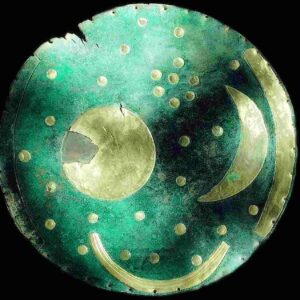
“If you have had your attention directed to the novelties of thought in your own lifetime, you will have observed that almost all really new ideas have a certain aspect of foolishness when they are first presented.” — A. Whitehead
“In science, unlike religion, the great revelations lie in the future; the coming generations are the authorities; and the pupil is greater than the master, if he has the gift to see things anew. All fruitful ideas have been conceived in the minds of non-conformists, for whom the known is still the unknown, and who often went back to begin where others passed by, sure of their way. The truth of today was the heresy of yesterday.” — I. Velikovsky
In Worlds in Collision, Immanuel Velikovsky claimed that the planets only recently settled upon their present orbits; that, in fact, great cataclysms have distinguished the recent history of the solar system. All agree that if true this thesis would have profound implications for various branches of natural science, particularly celestial mechanics and cosmology. Few agree, however, as to what constitutes valid evidence of the sort of events Velikovsky described.
Velikovsky himself, together with many of his supporters, suggested that “advance claims” regarding the state of various planets (such as the inordinate heat of Venus or radio-noises emanating from Jupiter, both anticipated by Velikovsky prior to their discovery) constituted prima facie evidence in support of the thesis. His critics, however, countered that correct predictions do not always constitute verification of the underlying thesis, while some even questioned the specificity and/or verification of Velikovsky’s advanced claims.1 Thus the question remains: What sort of evidence apart from Venus suddenly leaving its current orbit and resuming a comet-like appearance would it take to convince conventional scholars that that planet recently moved upon a different orbit–that the ancient skies were vastly different than the ones we see today?
It is apparently not enough that ancient peoples from around the world said as much. For example, a survey of ancient traditions reveals the following recurring motives: (1) in ancient times different “suns” dominated the visible heavens; (2) the world was once plunged into darkness and brought to the brink of destruction when the sun was eclipsed as a result of being swallowed by a giant dragon; (3) on one occasion, it is said, the planet Venus took on a comet-like appearance.2 Such traditions, in the rare event that they are encountered and subjected to analysis, are notoriously difficult to interpret, and, in any case, are typically explained away as poetic metaphor having little basis in reality.
In deference to the currently prevailing opinion which would downplay the importance of ancient mythological traditions, we seek a more “objective” source of evidence with which to explore the nature of the ancient cosmos. In addition to the ancient literary traditions, another record exists which offers evidence in support of recent changes in the solar system namely, prehistoric rock art. Ancient skywatchers from around the world have been drawing pictures of the celestial bodies since time immemorial, and the fact is that such pictures cannot be made to accord with the current arrangement of the solar system.
Prehistoric Petroglyphs of the Sun
The discovery in 1879 of spectacular paintings in the caves of Altamira (Spain) was initially met with disbelief and ridicule, so radical was the idea that Stone Age men could have created art of such sophistication and beauty. It was only upon the discovery of similar finds in France, Portugal and elsewhere in Europe that the scientific world became forced to accept the reality of Paleolithic rock art. Indeed, it has since been shown that rock art is abundant upon all inhabited continents and spans a period of time measured in millennia (the paintings of Altamira and Lascaux are typically dated to ca. 10-20,000 BCE).3
During the Paleolithic age, rock art was primarily devoted to the realistic representation of various forms of wildlife, the latter presumably objects of the hunt and rites of sympathetic magic.4 Especially common are paintings of horses and wisent, the great bison that once roamed the steppes of Europe, although mammoths, woolly Rhinoceroses, and other long extinct fauna also appear.
It was during the Neolithic age, apparently, that man began recording his perceptions of celestial phenomena through paintings and petroglyphs (incised images in rock). Not unlike fossilized bones, which provide an objective record against which to check the deductions drawn by paleontologists, rock art represents an objective record of mankind’s enduring interest in the stars and offers a check upon conclusions deduced from comparative mythology.
Among the most common petroglyphs are those typically interpreted as images of the sun. Included here are simple images featuring a circular disc from which “rays” emanate in all directions (see Figure 1).5 Certainly this is how one might expect our forbears to have depicted the current solar orb.
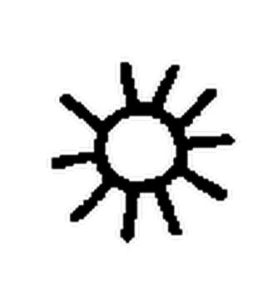
Other images, however, are more difficult to interpret. Consider Figure 2, one of the most common images in all of ancient rock art.6 It depicts what would appear to be a circular disc with a smaller orb set within its center.
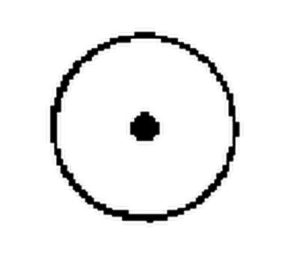
Even more difficult to reconcile with the current appearance of the sun is Figure 3, which depicts a flower-like object set against the backdrop of an orb or disc.7 Although less common than Figure 2, this image also has parallels throughout the ancient world.
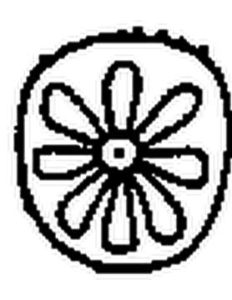
Consider further the image represented in Figure 4.8 How is it possible to explain the wheel-like “spokes” (typically four or eight in number) of this supposed solar-petroglyph by reference to the current sun?9 And yet this very image occurs throughout the ancient world! Most perplexing, perhaps, is the fact that such images occur in Neolithic contexts and thus predate by several millennia the invention of spoked wheels.

Figure 5, finally, adds a pillar-like appendage to the aforementioned images. 10 Here again we are dealing with a petroglyph of universal distribution, typically interpreted as the sun with “rays”.

Although the various “sun-images” occur in a wide variety of artistic contexts, it is not uncommon to find them associated with scenes of apparent worship and ritual. Well known, for example, are engravings depicting people offering salutations to the sun-god with upraised arms. In Camonica Valley, arguably the richest and most thoroughly excavated petroglyph site in the world, Anati observes: “The carvings of the first period are limited to the depiction of one person praying, facing the sun, which is drawn as a disc with a dot in its center.”11 Such scenes, coupled with the obvious prominence of the sun in ancient religion, have led scholars to assume that the solar images served some sort of religious purpose for the Stone Age artists and their communities.12
The anomalies presented by these images have not escaped the attention of scholars. Aside from the fact that each of them is routinely identified with the sun, the various “sun-images” would appear to have very little in common apart from the presence of a smaller orb in the center of a larger disc. In The Sun-Gods of Ancient Europe, M. Green offered the following observation: “It is very difficult to interpret the exact meaning of these sun-like images occurring on passage-grave stones. If we may assume that the signs are symbolic, then either they are purely abstract or they represent something in the natural world.”13
A. Willcox asks, not without some justification, why the ancients would need so many different symbols for the Sun? Noting that “the forms claimed to be solar symbols do not really look like the sun,” Willcox would regard them as non-representational in nature, and suggests their origin is rooted in physiology.14
There would thus appear to be two schools of thought with regard to these so- called solar images: that which would regard them as rooted in the natural world, and thus representational; and that which would regard them as non- representational. Inasmuch as each of these petroglyphs might be paralleled on any of the inhabited continents, it is difficult to accept the proposition that they are purely abstract in nature. Whatever they represent, it seems clear that the images had as their inspiration some objective reference in the natural world. How then do scholars explain the peculiar nature of the “sun- images”?
Here Green speculates that for some reason ancient man was unable (or disinclined) to depict the sun as it actually appears:
“When we look at the way that mankind in ancient Europe depicted the image of the sun, we see immediately that [its] obvious circularity dominated his perception. But what is more interesting is that man did not simply look at the sun and copy what he saw to the best of his ability. He went further and interpreted and superimposed new images of the sun which were not based entirely on his visual perception.”15
Why this should be the case is not intuitively obvious. One would think that part of communicating the sanctity of a religious symbol would be recording it faithfully, particularly if the symbol served a magical or apotropaic purpose (as, in fact, is known to be the case with “sun-signs”, which are featured prominently on amulets throughout the ancient world). Moreover, it is common to find “solar” petroglyphs upon the same rock face with images of animals and people, the latter drawn in relatively realistic fashion.16 Why then need we invoke subjective factors to explain the “solar” petroglyphs?
There is a very simple answer to this question: It is simply unthinkable to consider the logical alternative–that the petroglyphs faithfully depict the ancient “sun”, albeit one radically different in appearance from the current solar orb.
This is not to deny the possibility that sacred images become more abstract through time. Certainly representations of the ancient sun-god became more anthropomorphic as civilization progressed.17 But the question before us is not whether religious images are subject to evolution and transmutation; rather, why prehistoric images of the sun do not conform with its current appearance?
If one is willing to entertain the possibility that prehistoric rock art is representative in nature, how is it possible to discover the celestial phenomenon behind the various “sun-images”? Inasmuch as writing did not yet exist at the time most of these images were created, it would appear that we have reached a dead end in our investigation. Religious beliefs, however, are notoriously conservative in nature, and thus it may be possible to trace our solar forms in later art. Should this prove to be the case, we might gain therefrom some insight into the original significance of the prehistoric images. With this strategy in mind, we turn to consider the iconographical evidence from the ancient Near East, where we will find that strikingly similar images appear amongst the earliest art and writing.18
Pictographs of the Sun in the Ancient Near East
It is well-known that writing originated in the ancient Near East, first in Sumer and shortly thereafter in Egypt. In the earliest scripts, great reliance was placed upon pictographs in order to convey the message of the writer.19 Initially, the various pictographs represented familiar objects as realistically as possible, and thus in most cases it is possible to identify the natural objects depicted in the various pictographs. ‘pon further evolution of the script, however, the signs took on an increasingly abstract character (particularly in Mesopotamia, the Egyptian script generally retaining its pictographic form). The Assyrian character (glyph) , for example, is known to have evolved from a Sumerian pictograph featuring a bird.20
Recognizable amongst the earliest pictographs of the Sumerians, Egyptians, Maya and Chinese is the “solar” disc with central dot (our Figure 2). In both Egypt and China, this sign originally connoted “sun”.21 Other pictographs feature a rosette, a wheel-like disc, and the sun-disc upon a pillar, and thus resemble closely our Figures 3-5. Such correspondences support the conclusion that a certain continuity exists between prehistoric images of rock art and pictographic systems of writing, a conclusion reached by scholars on other grounds.22
There would also appear to be a general continuity with respect to the objects of worship.23 Thus it is well-known that the sun-god featured prominently in the earliest pantheons of both Sumer and Egypt. If we are looking for clues to the nature of the prehistoric sun-god, it is essential that we inquire into the sacred iconography associated with these cults.
Of the Sumerian sun-god Utu, relatively little is known. Indeed, even the reading of the god’s name is not beyond doubt.24 Among the symbols of god, however, appears our Figure 2, the sun disc with central dot set upon a pole.25
Better attested is the Akkadian Shamash, who appears in a wide variety of iconographical contexts. Upon countless cylinder seals and reliefs, for example, Shamash is depicted in anthropomorphic form emerging from the “mountain of the east”.26
The most common symbol for Shamash is shown in Figure 6, attested already in Akkadian times.27 In most cases the image features a circular disc, in the center of which appears a four-pointed star with wavy lines emanating between the points. This particular symbol may appear alone, or, more commonly, alongside a crescent and star, a patent reference to the intimate relationship believed to exist between Shamash, Sin and Ishtar, the divine triad of ancient Babylon.28 Although the crescent of Sin is readily understandable given the god’s customary identification with the Moon, why the ancient Babylonians would have represented the sun with this particular symbol is difficult to explain. The same image, moreover, is frequently found perched atop a pillar-like structure, raising further questions as to the objective basis of the image.29 Remembering the pillar-like appendage associated with early “sun” images in prehistoric rock art, one can’t help but wonder whether the Babylonian symbol of Shamash atop his pillar-like staff represents a stylized vestige of the former 30
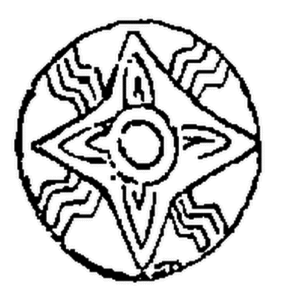
Elsewhere, however, Shamash could be represented by another symbol which features an eight-pointed star set against a circular disc (see Figure 7).31
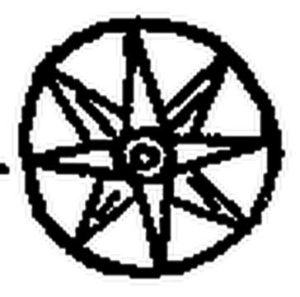
Here too, it must be admitted, it is difficult to see much resemblance between this image and the current solar orb. Why the ancient Babylonians would elect to represent their sun-god Shamash with an 8-pointed star is a question which bears careful consideration. Indeed, a satisfactory answer could portend a revolution in our understanding of the recent history of the solar system.
Stars and Planets in Early Pictographs
The eight-pointed star is one of the oldest pictographs in all of ancient Mesopotamia, occurring already during the prehistoric period (see Figure 8).32 According to leading scholars, the star-sign originally signified the concepts “God”, “Heaven”, or “An”, a clear indication, it would appear, of the celestial basis of Sumerian religion.33

In later times, scholars are agreed, the star came to be regarded as the special symbol of the planet Venus. This planet featured prominently in Sumerian religion, being identified with the goddess Inanna (her Akkadian counterpart being Ishtar).34 Indeed, according to Wolfgang Heimpel, the identification of Inanna and Venus was first made in prehistoric times and is apparent “in all historical periods.”35
In addition to the 8-pointed star, the planet-goddess Inanna could also be signified by several other pictographs.36 Prominent among these is the rosette (see Figure 9) which, like the “star”, commonly adorns artistic scenes and objects deemed sacred to the great goddess. About the antiquity of the rosette’s association with the goddess there is no doubt. Thus van Buren declares: “From the earliest times the rosette was a symbol of the goddess Innin-Ishtar.”37

Significantly, early examples of the rosette closely resemble the star, featuring little more than eight appendages or “arms” extending out from a central dot (see Figure 10).38
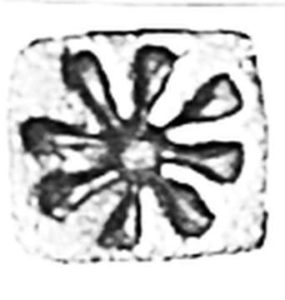
Indeed, as van Buren points out, it is probable that the rosette is artistically cognate with the eight-pointed star: “The eight-pointed star of Istar, frequently illustrated on monuments of the second and first millennia, was an adapted form of the archaic rosette as may be clearly seen from the star carved at the top of a kudurru from Susa.”39
Our discussion of the star of Ishtar has direct relevance to the question posed earlier: What is the significance of the 8-pointed star adorning the disc of Shamash? Given the intimate association of the star with the planet Venus, the question arises as to what relation, if any, exists between the 8- pointed-star in the Shamash-symbol and that which signifies Venus? Does this convergence of imagery mean that artistic license prevailed, or does it perhaps commemorate some hitherto unrecognized relationship between Venus and the ancient sun-god?40
The Sun and Venus in Ancient Egypt
That the worship of the sun and various celestial bodies belongs to the oldest Egyptian religion is commonly acknowledged. Countless passages in the Pyramid Texts, for example, allude to the King’s identification with the ancient sun- god and his intimate relationship to the morning star.41
In Egypt the star appears amongst the earliest pictographs, being found already upon predynastic pottery.42 Although both 8-pointed and 5-pointed stars are attested very early on, the 5-pointed star eventually came to predominate.
Here it is relevant to note that the image of a star superimposed upon a disc also appears in Egyptian hieroglyphic writing, as an ideogram for the underworld (see Diagram 11). This sign may be transcribed as either Dat or Duat, and is conventionally translated the “kingdom of the stars” or the “star-circle”.43 It is acknowledged, however, that both words are cognate with the name of the Morning Star: Duai.44 Indeed, according to T. Hopfner, the word Duat originally signified the Morning Star before later being used in the sense of “starry sky” or “underworld”.45 Thus it is reasonable to conclude that the Egyptian sign of the “star in disc”, like the Babylonian analog cited above, likewise had some reference to the planet Venus.
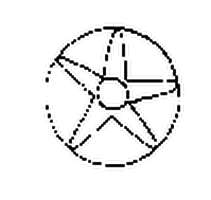
In Babylonian iconography, however, the star of Inanna/Venus was superimposed upon the disc of Shamash. Apart from the obvious resemblance of the disc of the Duat to the disc which elsewhere forms the backdrop of the sign of Re (Figure 2), is there any evidence linking the sign of the Duat to the ancient sun-god? The truth is that the evidence leaves no doubt upon the matter. Thus, in the Pyramid Texts the Duat is specifically identified as the domain of Re, thereby attesting to the region’s intimate relationship with the ancient sun-god.46 Elsewhere, the Duat is identified as the place from which the sun rose in the morning.47
The identification of the Duat as the netherworld on the one hand, and as the place where the sun rises on the other, strikes the modern reader as incongruous. Nevertheless, the idea of the sun-god as the regent of the netherworld was common throughout the ancient world.48 Here a most relevant parallel is to be found in Sumerian tradition, where the netherworld was known as Dilmun, described as ki-u4-e, “the place where the sun rises.”49 This epithet of Dilmun, significantly, finds a close parallel in the cult of Inanna. Thus, in an early hymn known as Inanna’s Descent to the Underworld, the goddess identifies herself as ki-d’tu-e-a-as, “Inanna of the place where the sun rises.”50 Such traditions suggest that the relationship between Venus and the netherworld, and between Venus and the ancient sun-god, was of a more intimate nature than hitherto suspected.
It might be objected here that the Egyptian sign of the Duat features a five- pointed star, while the Babylonian symbol of Venus features an eight-pointed star. While it is beyond the scope of the present article to investigate the significance of the various star-forms associated with Venus, suffice it to say here that Inanna/Ishtar could also be signified by a five-pointed star.51 Indeed, the five-pointed star as a symbol of Venus is well attested throughout the ancient world. Upon Babylonian kudurru, moreover, the Venusian pentagram can be found superimposed upon the disc of Shamash (Figure 12).52
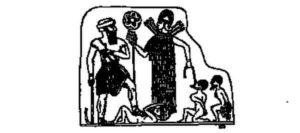
The Sun and Venus in Mesoamerica
Worship of the ancient sun-god and the planet Venus is as conspicuous in the New World as it is in the Old. Each of the so-called solar images (Figures 1 through 5) can be found in prehistoric petroglyphs, as can the eight-pointed star and pentagram.53
In most cases, of course, New World petroglyphs occur in contexts otherwise devoid of writing, and thus it is difficult to be certain which celestial body is the subject of the glyph. Such is not the case in Mesoamerica, however, which reached a high stage of civilization under the Olmec and Maya. In addition to developing a sophisticated system of writing, the Maya were also skilled astronomers, capable of calculating the period of Venus to within a fraction of its true value. Early symbols and pictographs of Mesoamerica, consequently, provide an invaluable key to unlocking the secrets of celestial imagery in prehistoric rock art.
A prominent characteristic of Mesoamerican astronomy–indeed of Mesoamerican culture in general–was an obsession with the planet Venus. Like their counterparts in ancient Babylon, Mesoamerican skywatchers chronicled the movements of Venus with amazing diligence and accuracy, viewing it as an agent of great omen and danger. Of the Mexican preoccupation with Venus a Spanish monk was led to report: “So accurately did they keep the record of the days when it appeared and disappeared that they never made a mistake.”54
It would be difficult to cite an aspect of Mesoamerican culture devoid of the planet’s influence. Temples were constructed and aligned with the purpose of gaining the optimum view of the planet; various rituals, including human sacrifices and the practice of war, were timed to correspond to important aspects of the planet’s orbit; even the calendar was designed to take into account the planet’s movements. Everywhere the sacred iconography associated with Venus abounds.
The omnipresent influence of Venus upon Mesoamerican culture invites comparison with Old World cultures, particularly that of Babylon. And, as we have documented elsewhere, the two cultures share much in common with respect to the sacred traditions and iconography surrounding the planet Venus.55
Among the Maya and Aztecs, for example, Venus was represented as a star. This was in keeping with its name “Great Star”, a common epithet of the planet amongst various peoples in Mesoamerica.56 Figure 13a depicts an Aztec symbol for Venus.57 This figure bears comparison with the four-pointed star which adorns the disc of Shamash in Figure 6. The resemblance is striking, down to and including the central point within the four-fold star. It is even possible that the volutes which distinguish the Aztec glyph correspond to the wavy-lines which emanate from behind the star in the Babylonian symbol. The resemblance between the Aztec symbol and the Mesopotamian, needless to say, supports the conclusion that the four-pointed star originated in the objective appearance of the planet Venus.
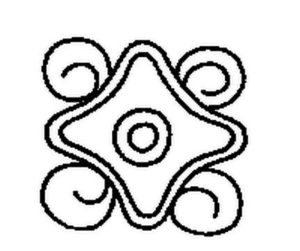
The same basic image is apparent in Figure 13b, a version of the Lamat-glyph, an acknowledged Maya glyph for Venus.58 Here the star is set against a circular disc not unlike that associated with Shamash in Figure 6.
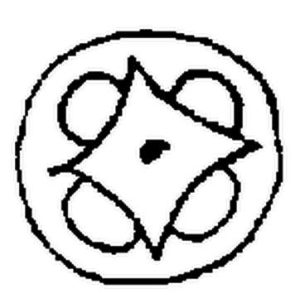
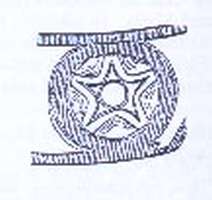
It is equally common, however, to find Venus depicted as a five-pointed star (see Figure 13c).59 Here too, the Mesoamerican symbol finds a close counterpart in the Babylonian cult of Ishtar/Venus (see Figure 12).
Figure 13 c
The Quincunx
As was the case in the ancient Near East, pictographs featured prominently in Mesoamerican systems of writing. Included among the earliest pictographs is one believed to be associated with the planet Venus (see Figure 14).60 Commonly known as a quincunx from the appearance of four circles about a central orb, it has been said that: “The quincunx is the most frequently occurring sign in the Mesoamerican symbolic language.”61 And, like the star in Mesopotamian iconography, the quincunx appears ubiquitously amongst the sacred iconography surrounding the planet Venus.
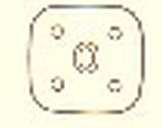
Given the Maya’s renowned obsession with heavenly phenomena, it is not surprising that other celestial objects also came to be represented on their sacred stelae and imposing stone monuments. The sun, for example, was commonly signified by a glyph known as the kin (see Figure 15).62 Of the kin- glyph, Thompson opined that it was probably derived from some type of four- petaled flower.63
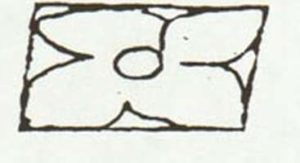
It is not uncommon, however, to find the quincunx-sign superimposed upon the kin-sign (see Figure 16).64 Of the meaning of this surprising superimposition of glyphs Thompson offers nary a clue, only the following observation: “The quincunx is frequently set on the regular four-petaled kin glyph, apparently without altering its value in any way.”65
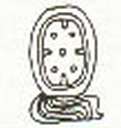
The reader will recognize at once, of course, that this is the very same situation we encountered in ancient symbols from the Old World. Again we ask: What could possibly be the significance of this bizarre convergence of iconography, whereby a sign of Venus is placed upon the sign of the sun?
Archaeoastronomers, confronted with this evidence from ancient hieroglyphs, might well be tempted to suggest that early scribes were trying to illustrate some important celestial event, such as the inferior conjunction of Venus and the sun. The latter is an event recurring every 584 days or so in which Venus passes directly between the Earth and the Sun. Unfortunate for the hypothetical thesis, however, is the fact that Venus is invisible during inferior conjunction and thus this would appear to be a most unlikely explanation of the glyphs in question.66
Another possibility, of course, is to assume that modern scholars have erred in their identifications of the glyphs for the Sun and Venus. This too is highly unlikely, at least with regard to the sign for Venus. What then can be the explanation for the glyphs in question?
The position taken in this essay accepts the ancient signs at face value–as faithful, albeit somewhat rudimentary attempts to depict a celestial phenomenon in which Venus appeared to be superimposed against the backdrop of a much larger sun-like orb. Those readers familiar with previous essays of Talbott and myself will recognize here a familiar theme.67
Summary
In the present essay we have documented that glaring anomalies distinguish the earliest iconography associated with the various celestial bodies. Prehistoric petroglyphs from around the world consistently portray the ancient sun-god in a fashion that bears little resemblance to the appearance of the current solar orb. Among the most common petroglyphs are those which show the solar disc equipped with a central dot, an eight-spoked body, a rosette, and a pillar-like appendage. The fact that the very same images appear amongst the earliest pictographs in Sumeria, Egypt, and Mesoamerica not only confirms the stubborn longevity of these sacred images, it offers some justification for the view that a continuity of beliefs (e.g. astral worship) likewise underlies the common images, thereby offering hope of discovering the original significance of the prehistoric petroglyphs upon analysis of their historical counterparts.
In Mesopotamia, as we have seen, the most ancient symbol of Shamash depicted a star set upon a circular disc. The star, however, originally signified the planet Venus, not only in Mesopotamia but also in Mesoamerica and Egypt. In light of the fact that the Babylonians and Maya are renowned for their astronomical prowess, particularly as it applied to the observation of Venus, we would venture forth the opinion that the stellar iconography surrounding this planet was representative in nature, and thus reflected the objective appearance of Venus in prehistoric times.
How then are we to explain the presence of the Venus-star upon the disc of the Sun? At the very least this juxtaposition of images suggests a hitherto unnoticed relationship between the planet Venus and the Sun, difficult to explain given the current relationship which pertains between these two bodies. More probably, these images allude to a “lost” solar system, one in which the planet Venus appeared to be superimposed upon a sun-like orb, the latter to be distinguished from the current solar orb.68
Support for this conclusion can be obtained upon further analysis of the prehistoric “sun-images”. Certainly there is a remarkable resemblance between the Venusian star in Figure 8a and the 8-spoked body adorning the sun-disc in Figure 4. Indeed, it is the opinion of this author that the 8-spoked body in Figure 4 does in fact represent the planet Venus and thus marks a prehistoric analogue of the eight-pointed star which adorns the symbol of Shamash in Figure 7.
Nor is it difficult to recognize a certain affinity between the rosette in Figure 9 and the flower-like object adorning the solar disc in Figure 3. That the rosette was one of the oldest symbols of Inanna/Venus is commonly acknowledged, as is its intimate relationship to the eight-pointed star.69 As we have seen, the eight-pointed star is frequently depicted as little more than eight-arms or spokes emanating from a central hub (Figure 10), and some early examples of the star, such as that from Elam depicted in Figure 8b, render the resemblance to the Venusian-rosette readily apparent. Indeed, the resemblance extends to the finest details of the respective images: Witness the dark dot located within the innermost core of the star, found not only in Figures 3 and 8b, but also within various examples of Figures 2 and 13.70
Having discussed the images represented by Figures 3 and 4, it remains to discuss Figure 2, the most common petroglyph of the “sun” and one of the most prominent images in all of ancient art (Figure 5 will be dealt with at length in a subsequent essay). If we are to be consistent, the smaller orb is to be identified with the planet Venus. That the same body may at one time be represented as a star and elsewhere as an eye-like orb upon the face of the sun-god need not be a contradiction. In ancient times, perhaps, the planet went through cyclical phases, not unlike our current Moon, which alternately presents the appearance of a crescent and a circular disc.71 More probably, the different images associated with the planet Venus represent different stages in the evolutionary history of the planet, particularly as it related to that planet’s interaction with the ancient sun-god and other bodies in the solar system. It can be shown, in fact, that the planet Venus underwent various metamorphoses in appearance during its long-term association with the ancient sun-god. During the course of the past decade, Talbott and myself have discussed several of the more clearly delineated phases in the history of Venus.72 Among the most prominent, as we have documented in great detail, is the phase in which Venus was identified with the eye of the sun-god. Thus it is that Venus is identified with an eye, or with the eye of the ancient sun- god, throughout the ancient world.73 In ancient Egypt, to take the most familiar example of this motive, the Eye of Ra–one of the most sacred objects in all of Egyptian religion–is identified with Venus.74 And the glyph for Ra, it will be remembered, is our Figure 2!
Conclusion
Together with the polychrome paintings of bison and mammoths on the cave walls at Altamira, ancient images of the “sun” and planet Venus provide compelling evidence of lost worlds. The hypothesis that Venus moved upon a radically different orbit in very recent times (during the Neolithic age, perhaps) will no doubt be met with the same skepticism as that which greeted the discovery of the Paleolithic cave-paintings in the past century. Be that as it may, the testimony of ancient rock art is not to be explained away. Indeed, it is our opinion that the evolutionary history of the solar system can be reconstructed in great detail upon analysis of ancient iconography and mythology. Like the ancient oracle at Delphi, the mysterious images engraved in stone call out to us with news of the ancient gods. But given the cynical nature of the modern world, who among us will listen?
Footnotes
1 This was a frequent ploy of Sagan, for example: C. Sagan, “An Analysis of Worlds in Collision,” in D. Goldsmith, ed., Scientists Confront Velikovsky (New York, 1979), pp. 99ff.
2 I. Velikovsky, Worlds in Collision (New York, 1950).
3 See the discussion in A. Willcox, The Rock Art of Africa (Kent, 1984), pp. 1- 5.
4 H. Breuil & H. Obermaier, The Cave of Altamira (Madrid, 1935), p. 12; F. Windels, The Lascaux Cave Paintings (London, 1949), p. 127.
5 This image is taken from M. Devlet, Petroglify Mugur-Sargola (Mockba, 1980), Figure 20, p. 237. Close parallels can be found in E. Twohig, The Megalithic Art of Western Europe (Oxford, 1981), Figures 49 and 217; and E. Anati, Camonica Valley (New York, 1961), p. 95. On the age of these petroglyphs Anati writes: “The most ancient Valley carvings dealing with sun worship belong to the end of the Stone Age, to the second half of the third millennium BC. At that period the sun is drawn as an isolated disc; seldom is it accompanied by a person with hands upraised in an attitude of prayer, or by an abstract sign.” Anati, op. cit., p. 162.
6 E. Anati, op. cit., p. 162. See also R. Heizer & C. Clewlow, Prehistoric Rock Art of California (Ramona, 1973), Figure 329. Of this image, Anati remarks: “This kind of symbolic representation of the sun is common to many primitive societies and ancient civilizations. It occurs in the ancient Near East, in the Far East, as well as in Europe and elsewhere.” op. cit., p. 47.
7 This image, taken from Cairn T of Lough Crew, forms Figure 235 in E. Twohig, The Megalithic Art of Western Europe (Oxford, 1981). For a parallel from the New World see R. Heizer & C. Clewlow, op. cit., Figure 85.
8 See Figure 238 from Twohig, op. cit.; Figure 8:4 from A Willcox, The Rock Art of Africa (London, 1984), p. 83; Figure 10 from L. Cressman, Petroglyphs of Oregon (Eugene, 1982), p. 20; Figure 24 from P. Schaafsma, Indian Rock Art of the Southwest (Santa Fe, 1980), p. 44; Figure 208 from C. Dubelaar, The Petroglyphs in the Guianas and Adjacent Areas of Brazil and Venezuela: An Inventory (Los Angeles, 1986), p. 197.
9 Of the wheel-like images Anati observes: “A number of hypotheses have been advanced in an attempt to explain them, but none is truly satisfactory.” op. cit., p. 163.
10 E. Anati, op. cit., p. 162. See also Figures 189 and 283 from P. Schaafsma, Indian Rock Art of the Southwest (Santa Fe, 1980), pp. 230 and 340; Figure 8.4 from A Willcox, The Rock Art of Africa (London, 1984), p. 83; Figure 73 from C. Dubelaar, The Petroglyphs in the Guianas and Adjacent Areas of Brazil and Venezuela: An Inventory (Los Angeles, 1986), p. 87.
11 E. Anati, op. cit., p. 47.
12 Ibid., p. 230.
13 M. Green, The Sun-Gods of Ancient Europe (London, 1991), p. 27.
14 A. Willcox, op. cit., pp. 97, 239-244.
15 Ibid., p. 33.
16 With respect to the rock art of the Camonica Valley, Anati observes: “The scenes are engraved in realistic style and with great precision of detail.” op. cit., p. 23.
17 E. Anati, op. cit., p. 111.
18 Here a leading authority has offered the following observation: “Interpretations of a religious cult which originated in the dawn of civilization must necessarily be tentative or purely hypothetical. Its real significance can only be surmised from what we know of the traces of it which survived into later and more literate ages.” See E. van Buren, “New Evidence Concerning an Eye-Divinity,” Iraq 17 (1955), p. 172.
19 E. Budge, Egyptian Language (New York, 1983), p. 2; M. Thomsen, The Sumerian Language (Copenhagen, 1984), p. 20.
20 H. Frankfort, The Birth of Civilization in the Near East (Garden City, 1950), Figure 13.
21 J. Norman, Chinese (New York, 1988), p. 61; E. Budge, op. cit., p. 74.
22 W. Arnett, Predynastic Origin of Egyptian Hieroglyphs (Washington DC., 1982), pp. 9-21. M. Uyanik, Petroglyphs of South-Eastern Anatolia (Graz, 1974), p. 15.
23 With respect to solar elements in Mesopotamian religious cult, Goff concluded: “This study suggests that there was more continuity of religious values in prehistoric art than has usually been recognized.” See B. Goff, Symbols of Prehistoric Mesopotamia (New Haven, 1963), p. 89.
24 Ibid., p. 236.
25 D. Wolkstein & S. Kramer, Inanna: Queen of Heaven and Earth (New York, 1983), pp. 30, 185.
26 E. van Buren, “The Sun-God Rising,” Revue d’Assyriologie 49:1 (1955), pp. 1- 14.
27 H. Prinz, op. cit., Tafel X: no. 1. See also B. Hrouda, “Gottersymbole und Attribute,” Reallexikon der Assyriologie III (1957-1971), p. 485.
28 H. Prinz, op. cit., pp. 53-65.
29 Ibid., pp. 90-94. According to van Buren, most examples of the disc on a post occur on cylinder seals of the Early Babylonian period and upon seal impressions on “Cappadocian” tablets. See Figure E-8 in Van Buren.
30 The staff of Shamash, moreover, has a precise parallel in the rod of Helios.
31 E. van Buren, Symbols of the Gods in Mesopotamian Art (Rome, 1945), p. 88. Such is the case on the stelae of Naram-Sin and Gudea, for example. It is noteworthy that these are two of the oldest examples of the sign of Shamash.
32 B. Hrouda, op. cit., p. 485. See Figure 306 in B. Goff, Symbols of Prehistoric Mesopotamia (New Haven, 1963).
33 R. Labat, Manuel D’Epigraphie Akkadienne (Paris, 1963), p. 48. Jeremias made much the same point with respect to the astral nature of early Mesopotamian religion at the turn of the century. See A. Jeremias, “Sterne,” RML, col. 1439.
34 E. van Buren, Symbols of the Gods, (Rome, 1945), p. 82. Numerous cultic images of the goddess likewise bear the sign of the star. Ibid., pp. 83-85. See also U. Seidl, “Inanna/Istar,” in Reallexikon der Assyriologie Vol. 5 (Berlin, 1976-1980), p. 86.
35 W. Heimpel, “A Catalog of Near Eastern Venus Deities,” Syro-Mesopotamian Studies 4:3 (1982), p. 12.
36 In the earliest pictographic script Inanna was signified by a sign interpreted as a ring-post with bundle. We will explore the original significance of this symbol in a future essay.
37 E. van Buren, “The Rosette in Mesopotamian Art,” ZA 45 (1939), pp. 99-107.
38 See D. Wolkstein & S. Kramer, Inanna: Queen of Heaven and Earth (New York, 1983), pp. 60, 67.
39 Van Buren, op. cit., p. 105. Labat also relates the rosette to the earlier eight-pointed star. Labat, op. cit., p. 48.
40 F. Steinmetzer went so far as to explain the presence of the eight-pointed star on the disc of Shamash as an error on the part of the artist. F. Steinmetzer, Die babylonischen Kudurru (Grenzsteine) als Urkundenform (Paderborn, 1922), p. 181. Significantly, an 8-pointed star also graces the disc of the sun in Mesoamerican iconography. See Figure 8e in A. Aveni, Skywatchers of Ancient Mexico (Austin, 1980).
41 R. Faulkner, “The King and the Star-Religion in the Pyramid Texts,” JNES 25 (1966), pp. 153-161.
42 W. Arnett, The Predynastic Origin of Egyptian Hieroglyphs (Washington DC., 1982), pp. 13-14.
43 E.H., “Dat,” Reallexikon der Egyptologie Vol. I (Berlin, 1977), pp. 994-995.
44 E.O., “Duai,” Reallexikon der Egyptologie Vol. I (Berlin, 1977), p. 1147.
45 M. Stracmans & G. Libon, “Le nom de la planete Venus et ses antecedents egyptiens,” Latomus 6 (1947), p. 5.
46 Line 272a-273b.
47 Line 306a. See here the discussion in S. Mercer, The Pyramid Texts Vol. 4 (New York, 1952), p. 34. See also H. Brugsch, Die Agyptologie (Amsterdam, 1970), p. 327.
48 M. Astour, Hellenosemitica (Leiden, 1967), p. 287.
49 A. Sjoberg and E. Bergmann, The Collection of the Sumerian Temple Hymns (Locust Valley, 1969), p. 89.
50 Lines 80-81. See here the discussion of A. Sjoberg and E. Bergmann, op. cit., pp. 89-90. That this passage specifically relates to Inanna in her aspect as the planet Venus is generally recognized by scholars. See. W. Heimpel, op. cit., pp. 9-10.
51 F. Steinmetzer, Die Babylonischen Kudurru (Grenzsteine) als Urkundenform (Paderborn, 1922), p. 181. See also A. Jeremias, Handbuch der altorientalischen Geisteskultur (Leipzig, 1913), p. 100.
52 A. Jeremias, op. cit., p. 77.
53 For examples of the five-pointed star see R. Heizer & C. Clewlow, Prehistoric Rock Art of California (Ramona, 1973), Figures 34, 37, 40, 91, 272; for examples of the eight-pointed star see Figures 298 and 364; for the eight-spoked “wheel”, see Figures 47 and 371; for rosette-like images see Figures 76, 85, and 275. Examples of the “sun” with rays, “sun” with central dot, and “sun” with pillar can be found on virtually every page of this book.
54 Quoted in A. Aveni, “Venus and the Maya,” American Scientist 67 (May/June, 1979), p. 274.
55 D. Talbott & E. Cochrane, “When Venus was a Comet,” Kronos XII:1 (Winter 1987), pp. 2-24.
56 E. Thompson, Maya Hieroglyphic Writing (Norman, 1975), p. 218. Similar names for Venus will be found around the world. The Polynesian Islanders, for example, refer to Venus as Hokutoa, “Great Star”. M. Makemson, The Morning Star Rises (New Haven, 1941), pp. 141, 193-4, 207.
57 L. Sejourne, Burning Water (Berkeley, 1976), p. 90.
58 W. Gates, An Outline Dictionary of Maya Glyphs (New York, 1978), p. 149.
59 Figure 1i in J. Carlson, Venus-regulated Warfare and Ritual Sacrifice in Mesoamerica: Teotihuacan and the Cacaxtla “Star Wars” Connection (College Park, 1991).
60 L. Sejourne, Burning Water (Berkeley, 1976), p. 91. See also B. Stross, “Some Observations on T585 (Quincunx) of the Maya Script,” Anthropological Linguistics 28 (1986), p. 294; E. Thompson, op. cit., p. 171.
61 L. Sejourne, op. cit., p. 91.
62 Figure 26:49 of E. Thompson, Maya Hieroglyphic Writing (Norman, 1975).
63 E. Thompson, op. cit., p. 142.
64 Figure 26:51 of E. Thompson, op. cit.
65 E. Thompson, op. cit., p. 172.
66 Recently, however, the possibility that Venus could occasionally be observed during inferior conjunction has been co nsidered.
67 D. Talbott & E. Cochrane, “The Origin of Velikovsky’s Comet,” Kronos X:1 (Fall 1984); idem., “On the Nature of Cometary Symbolism,” Kronos XI:1 (Fall 1985); idem., “When Venus was a Comet,” Kronos XII:1 (Winter 1987). D. Talbott, “Mother Goddess and Warrior-Hero,” AEON I:5 (1988), pp. 38-65; “The Mythical History of the Comet Venus,” AEON II:4 (1991), pp. 29-48; E. Cochrane, “On Comets and Kings,” AEON II:1 (1989), pp. 67-70; “The Birth of Athena,” AEON II:3 (1990), pp. 25-28.
68 See here D. Talbott, The Saturn Myth (New York, 1980); D. Cardona, “Intimations of an Alien Sky,” AEON II:5 (1991), pp. 5-34.
69 Significantly, Venus was also compared to a flower in the New World. Thus a Maya name for the planet was u lol zaz caan, “the luminous (big) flower of the sky.” See W. Lamb, “Star Lore in the Yucatec Maya Dictionaries,” in A. Aveni, ed., Archaeoastronomy in Pre-Columbian America (Lubbock, 1975), p. 234.
70 That the dark dot actually depicts the planet Mars will be demonstrated in a subsequent essay. For the logic behind this statement see D. Talbott, “Mother Goddess and Warrior-Hero,” AEON I:5 (1988), pp. 41-45; E. Cochrane, “The Death of Heracles,” AEON II:5 (1991), pp. 67-68.
71 Jeremias and Weidner both held that the phases of Venus must have been visible in order to account for references to the “horns” of Venus in ancient Babylonian astronomical texts. See Jeremias, op. cit., p. 79.
72 See D. Talbott & E. Cochrane, “When Venus was a Comet,” Kronos XII:1 (Winter 1987), pp. 14-16; D. Talbott, “The Mythical History of the Comet Venus,” AEON II:4 (1991), pp. 36-43; E. Cochrane, “On Comets and Kings,” AEON II:1 (1989), pp. 25-28.
73 In Australia, for example, Venus was known as Mimungoona, “Big Eye”. Polynesian islanders referred to Venus as Tamata-nui, “Great-Eye”. The Maya likewise compared Venus to an eye, naming the planet Nohoch Ich, “Great Eye”. See D. Talbott, “The Mythical History of the Comet Venus,” AEON II:4 (1991), pp. 42-44; D. Talbott & E. Cochrane, “When Venus was a Comet,” Kronos XII:1 (Winter 1987), pp. 14-16; E. Thompson, op. cit., p. 218.
74 R. Anthes, “Mythology in Ancient Egypt,” in S. Kramer, ed., Mythologies of the Ancient World (New York, 1961), pp. 89-90.